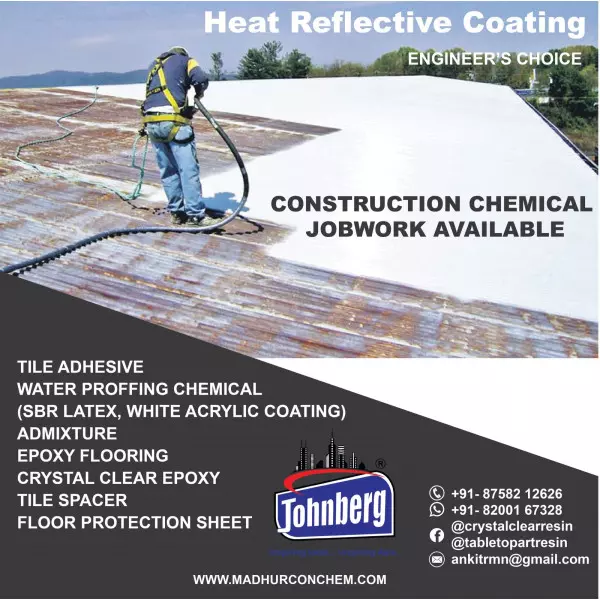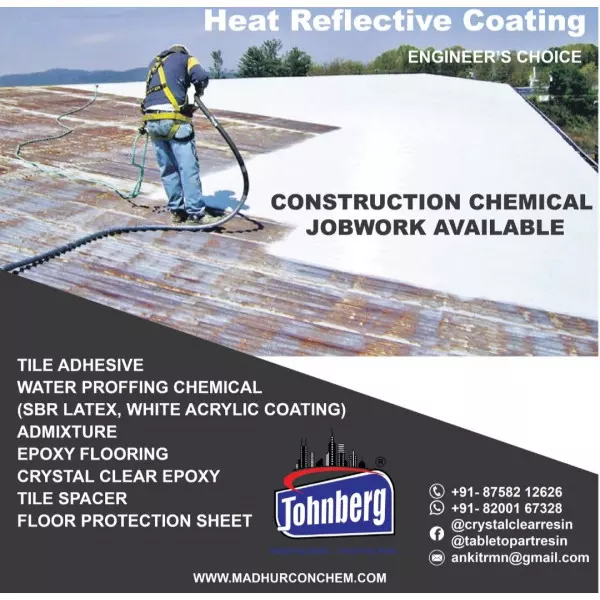- Home
- About Us
- Products
- Resin Furniture
- 3D Epoxy Flooring Service
- Resin Table Top
- Wooden Epoxy Resin Table Top
- Metallic Epoxy Flooring Service
- Conception Chemical Consultants
- Chemical Consultancy For Construction
- Construction Chemical Consultant
- Tile Grout
- Foundation Grout Consultant
- Paver Block Chemical Consultant
- Waterproofing Chemical Consultant
- Epoxy Pigment Consultant
- Heat Reflective Coating
- Water Repellent Coating
- Epoxy Grout
- Chemical Consultant
- Industrial Chemical
- Construction Chemical
- Epoxy Resin
- Epoxy Coating
- Polyester Resin
- Joint Sealants
- Cristal Clear Epoxy Resin And Hardner
- Construction Chemicals
- Polycarboxylate Ether And Liquid
- Solvent Cement
- Tile Protection Sheet
- Water Reducing Superplasticizer
- Epoxy Resin And Hardeners
- Two Component Waterproof Coating
- Epoxy Floor Coatings
- Casting Resin
- Sbr Latex Polymer
- Epoxy Grout Formulations
- Epoxy Resin Tabletops
- Tile Spacers
- Tile Levelling Spacers
- Industrial Night Vision Epoxy Grout
- Sbr Latex
- Johnberg Marble Polishing Liquid
- Acrylic Elastomeric Coating
- Weber Tile Adhesives
- Decorative Arts
- Resinic Crafts
- PU Flexible Tile Adhesive
- Resin Pressed Flowers
- Dry Pressed Flower
- Epoxy Putty
- Resin Furniture
- Services
- Updates
- Gallery
- Contact Us
Heat Reflective Coating Service In Gujarat
Details of Heat Reflective Coating
Heat Reflection Coating (also known as cool roof coating, solar reflective coating, or thermal reflective coating) is a specialized surface treatment designed to reflect more sunlight and absorb less heat than standard roofing or wall materials. These coatings are widely used in buildings, industrial facilities, vehicles, and even pavements to improve thermal comfort and energy efficiency.
Key Details of Heat Reflection Coating
Purpose
Reduce Heat Absorption: Reflects a significant portion of solar radiation.
Improve Energy Efficiency: Decreases need for air conditioning.
Extend Roof Life: Reduces thermal expansion and UV degradation.
Improve Comfort: Keeps indoor temperatures lower in hot climates.
Composition
Heat reflective coatings typically contain:
High Solar Reflectance Pigments (e.g., titanium dioxide, ceramic microspheres)
Acrylic or Elastomeric Polymers (for flexibility and adhesion)
UV Stabilizers and Additives (to resist weathering and yellowing)
How It Works
Reflects Visible & Infrared Light: Instead of absorbing solar energy, the coating reflects it.
Emits Thermal Radiation: The material also cools itself by emitting infrared radiation (high thermal emittance).
Reduces Surface Temperature: Surfaces coated with reflective material can be 20–50°C cooler than untreated surfaces.
Performance Metrics
Solar Reflectance (SR): % of solar energy reflected (ranges from 0 to 1; higher is better)
Thermal Emittance (TE): Ability to release absorbed heat (0 to 1 scale)
SRI (Solar Reflectance Index): Combined measure of reflectance and emittance
Example:
Material Solar Reflectance Thermal Emittance SRI
Black Roof 0.05 0.90 0
White Coating 0.85 0.90 >100
Types of Surfaces it Can Be Applied To
Concrete roofs
Metal roofs
Asphalt shingles (with suitable primer)
Wall exteriors (for building envelopes)
Pavements and roads
Benefits
Energy savings (up to 15–30% in cooling energy)
Reduced Urban Heat Island effect
Improved HVAC efficiency
Lower carbon footprint
Durability and UV protection
Compliance with green building standards (LEED, IGBC, ECBC)
Application Process
Surface preparation: Clean and repair surface.
Primer (if needed): For better adhesion.
First coat: Applied with brush, roller, or spray.
Second/third coats: After curing, for proper thickness (typically 1–2 mm).
Inspection and testing: Check for cracks, blisters, or incomplete coverage.
Limitations
Less effective in cold climates (may reduce beneficial heat gain in winter).
Not a substitute for insulation (works best in combination).
Needs regular maintenance and reapplication every few years.
Limited performance on shaded or dusty surfaces.
Popular Brands (India & Global)
India: Asian Paints SmartCare, Dr. Fixit HeatShield, Berger WeatherCoat
Global: GAF EnergyGuard, Henry Tropi-Cool, Koolseal, Rhino Shield
Offered Product
Heat Reflective Coating
BrandJohnbergUsage/ApplicationRoofsColorWhitePaint Base TypeWater BasedIs It WaterproofYesCountry Of OriginMade In IndiaProducts DescriptionWHITE ELASTOMERIC ROOF COATING Is A Water-based 100% Acrylic Latex Coating. It Is Designed To Reduce Surface Temperature And Penetration Of The Sun's Rays, Which Helps Lower Roof And Interior Temperatures As Well As Energy Costs. Properly Applied, It Is Highly Resistant To Disbonding, Chalking, Mildew, Fungi, And Discoloration.UsagePreviously Coated Acrylic ... Read moreHeat Reflective Coating Manufacturers In Porbandar
Clients Can Avail The Offered Range Of Heat Reflective Coating From Us. The Offered Range Is Designed With The Aid Of First-class Quality Material And Highly Developed Technology In Fulfillment With Set Industrial Norms. This Range Of Products Is Carefully Tested On An Assortment Of Quality Parameters To Ensure Its Effectiveness And Amazing Quality. We Offer This Product In Miscellaneous Specifications As Per The Requirements Of The Clients. Our Given Range Is Most Applauded Among Clients. Continue
Heat Reflective Coating Ahmedabad
Heat-reflecting Coatings Are Specially Formulated Substances Applied To Surfaces To Reduce The Amount Of Heat Absorbed By The Material. These Coatings Typically Reflect Infrared (IR) Radiation, Which Is A Significant Source Of Heat Transfer, While Allowing Visible Light To Pass Through. The Primary Goal Of Heat-reflecting Coatings Is To Improve Energy Efficiency, Reduce Heat Buildup, And Lower Cooling Costs In Buildings Or Vehicles.Common Types Of Heat-reflecting Coatings Include:Solar Refle Continue
Heat Reflective Coating System Manufacturers In Udaipur
Heat Reflective CoatingHeat Reflective Coating Is A Type Of Paint Or Surface Treatment That Helps Reflect Sunlight And Reduce Heat Absorption. It Is Commonly Used On Roofs And Exterior Walls To Lower Indoor Temperatures And Improve Energy EfficiencySolar Reflectance: This Coating Reflects A Large Portion Of Solar Radiation, Preventing Surfaces From Getting Too Hot.Thermal Emittance: It Releases Absorbed Heat Quickly, Helping The Surface Cool Down Faster.Energy Saving: By R Continue




